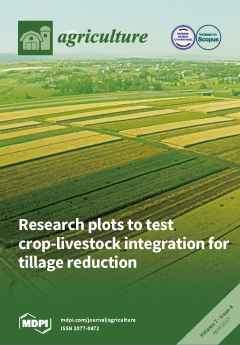The impact of chemical farming and the negative consequences on the environment and human health in Bangladesh are on the rise. Organic farming is gaining attention and increasing globally because it is eco-friendly, safe and has benefits for human health. A field study
[...] Read more.
The impact of chemical farming and the negative consequences on the environment and human health in Bangladesh are on the rise. Organic farming is gaining attention and increasing globally because it is eco-friendly, safe and has benefits for human health. A field study was conducted at the horticulture farm of Bangladesh Agricultural University (BAU), Mymensingh, to evaluate the growth and yield performance of cabbage cv. Atlas—70 using organic and inorganic fertilizers in various plant spacing arrangements. Two factor experiments were conducted on plant spacings of 60 cm × 40 cm (S
1), 60 cm × 50 cm (S
2) and 60 cm × 60 cm (S
3) and fertilizers vermicompost (T
1), biogen (T
2), integrated plant nutrient system (IPNS) Organic (⅔) + inorganic (⅓) (T
3) and inorganic (T
4). IPNS (T
3) application increased the marketable yield (54.77 t·ha
−1) of cabbage. The highest marketable yield (48.75 t·ha
−1) was obtained with a plant spacing of 60 cm × 40 cm (S
1). No significant variation was found in plant spacings S
1 and S
2. The treatment combination of S
2T
3 recorded the highest plant height (37.81 cm), plant spread (47.75 cm), cabbage head (21.80 cm), stem length (12.31 cm), thickness of the cabbage head (12.53 cm) and marketable yield (65.0 t·ha
−1). The results suggest that IPNS (T
3) combining organic and inorganic fertilizer applications with a 60 cm × 50 cm spacing (S
2T
3) increases the yield performance of cabbage.
Full article





